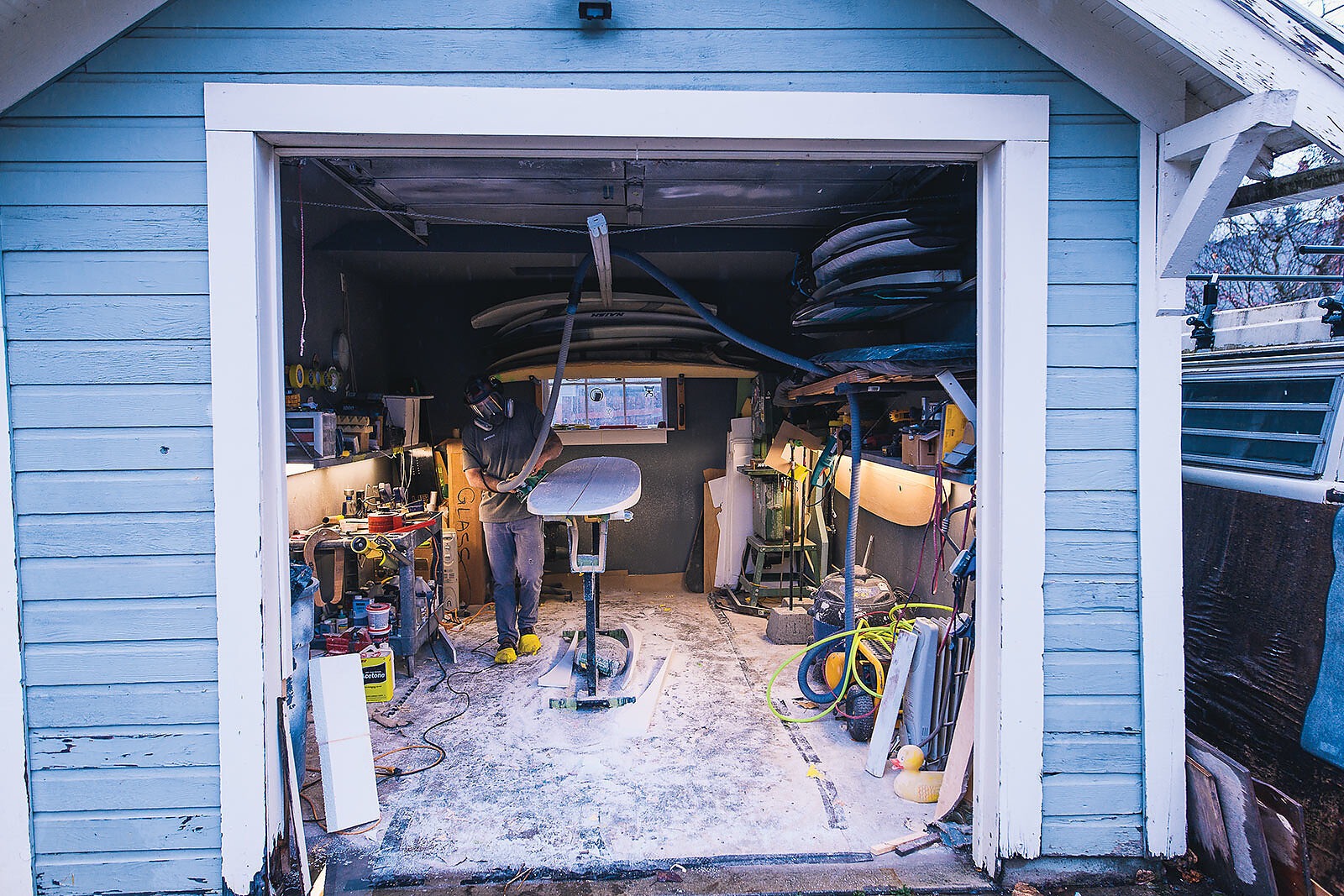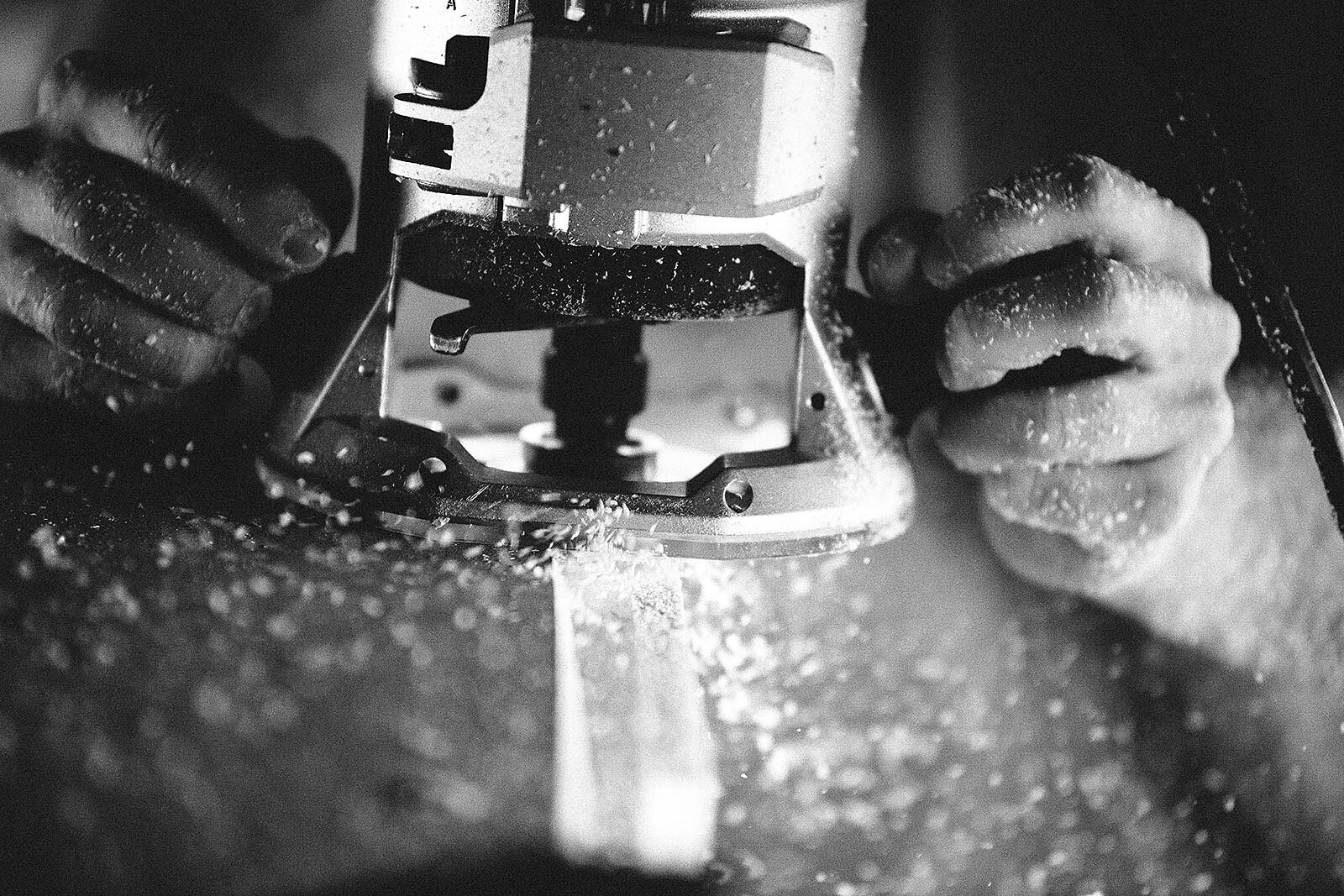
Subtle Shapes Maddy Marshall and the Various States of Flow
Words by Jann Eberharter | Photos by Paris Gore
The first surfboard Maddy Marshall ever shaped, he miscalculated the amount of resin needed for the fiberglassing process.
To work around the slight shortage, he opted out of placing a leash plug, which meant when it was finished, there would be no way to connect himself to the board.
“I wasn’t that great of a surfer at the time, so I remember I got my first wave, [then] lost the board and had to swim in to get it,” he says. “I felt like a little bit of a kook, but it was a pretty good wave."
Four years and some 20-plus boards later, it’s a very different story. As chilly December rain begins to fall from a dark sky, a sliver of light emanates from beneath a garage door in Bellingham, WA. Inside the 10-foot-by-20-foot detached garage-turned-shaping-bay, Maddy is making the first cuts into a piece of Styrofoam. Every surfboard begins as a “blank”—an uncut rectangle of foam with a wood stringer at its center—before being shaped into a surfboard through a series of subtle reductions. Then the foam is covered with fiberglass and resin to give it a durable, rigid and—most importantly—waterproof outer layer.
The whole process takes anywhere from 10 to 15 hours, depending on the size and shape. With a full-time school schedule and part-time job on his plate, Maddy finds time to hunker down in the shaping bay when he can. Having a relaxed schedule during the holidays, he decided it was a good time to check a board off the waiting list between a trip to the coast and a few days spent chasing powder.

Growing up in Olympia, WA, Maddy had surfed at nearby Westport a few times as a kid, but was never really hooked. He eventually moved to Bellingham, WA for college and after earning an economics degree from Western Washington University, a friend convinced him to take a job at a surf and kiteboard shop in North Carolina’s Outer Banks. As an avid kiteboarder, it was a no-brainer.
“I thought it was a great idea because I didn’t want to use my economics degree,” he laughs. “It was good gig.”
To those unfamiliar with geography, the idea of surf in North Carolina might seem far-fetched. But the Outer Banks, a narrow string of islands 10 miles off the mainland, has no shortage of waves, and it was here Maddy began to surf daily. About the same time, a friend outfitted a cargo trailer into a surfboard shaping bay and gave Maddy a rundown of the basics. “I made a really bad board,” he says. Still, it worked.
In 2016, he moved back to Bellingham and found a job at Kite Paddle Surf, the town’s lone kiteboard and surf shop. Serendipitously, the shop’s owner, Dave Sanford, had a shaping bay in his garage he didn’t often use. Intrigued by his first attempt, and under Sanford’s tutelage, Maddy continued to shape boards and learn the finer details of the craft.
“I got [Dave] to show me how to shape a board correctly, shaped one, and then just kept on shaping,” Marshall says. “It was pretty addicting.”
Under the moniker New Moon Surfboards, he amassed a list of requests for boards, mostly from friends and friends of friends, many of whom became close friends in their own right. Bellingham is a five-plus-hour drive to breaking waves, which means the town’s surf contingent is small and dedicated. Whether heading to Vancouver Island, the Olympic Peninsula or Oregon, it’s common to see familiar faces.
“The Washington coast produces some tough but friendly surfers,” Maddy says. “I still remember my first time putting on a solidly frozen wetsuit—I couldn’t help but laugh, drink some whiskey and go surf.”

Back in the shaping bay, where Maddy is turning out a beautiful nine-foot single-fin board, the vibes are warm and welcoming. He cracks a beer as he stirs resin for the board’s first coat, before tinting it deep purple. With sheets of fiberglass already laid over the board, Maddy meticulously pours the viscous solution on top, moving puddles of mulberry resin around in a slow and methodical pattern.
The dynamism of shaping has its commonalities with surfing, unsurprisingly, but it also bleeds into the world of two wheels. Only a few blocks beyond these walls are the trails of Galbraith Mountain, where Maddy frequently finds his out-of-the-ocean flow.
“The flowy-er kind of trails where you just zone out, go into a flow state, are kind of similar to surfing, where you don’t really think about anything when you’re doing it,” Maddy says of mountain biking.
The feeling of being completely in the moment is something many sports share, and is perhaps one reason people find solace in these activities. The mediums might be different, but the methodologies are innately similar. It’s this sensation, mixed with the home-grown originality of Maddy’s boards, that people find desirable.
“There’s a bunch of local bike companies around, and it’s fun to ride those [bikes],” Maddy says. “If there’s a [local] surfboard option, it’s a pretty cool option to explore.”
Even now as a venerable shaper, Maddy will be the first to admit he still learns with every board. Whether it’s the intricacies of the process, the tools he uses, or the feedback he gets while riding a wave, every insight is a step toward making a better board. No one surfboard will ever be the ultimate shape, a fact that’s as maddening as it is enlightening, but the impossibility of shaping the perfect board is something Maddy doesn’t seem to find disconcerting. After all, it’s never really been about the board, but rather the ride.
“Seeing all my friends ride my boards,” Maddy says, “and get really good waves on them—that’s a cool feeling.”